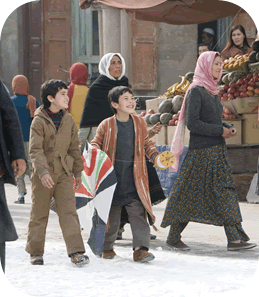
I had one last chance to make a decision. One final opportunity to decide who I was going to be. I could step into that alley, stand up for Hassan-the way he’d stood up for me all those times in the past-and accept whatever would happen to me. Or I could run. In the end, I ran.
This was the end of innocence in Amir’s life. The Kite Runner is a coming-of-age or loss-of-experience novel, the type of book often read by teenagers. It is a popular genre because it continually speaks to the human condition. Similar novels that you may have read in English are Montana 1948, To Kill a Mockingbird and The Catcher in the Rye. Often these novels are written from the male perspective, as is The Kite Runner but you may have read parallels from a female perspective such as Sue Monk Kidd’s The Secret Life of Bees.
The Kite Runner has some things in common with other stories of loss of innocence and coming of age. Before the pivotal event of Hassan’s rape Amir lived in relative innocence. Amir’s world is one of school and home, movies and kites, friends and bullies, and wanting to please Baba. Most of his thoughts are focused on himself: his desire to win the kite fighting competition; his selfish, self-centred, and sometimes cruel treatment of Hassan. On the same day that his innocence was taken away, he thought the greatest thing in life was a kite fighting victory that would ensure a happy ending for him. Amir was just starting to think about real issues in life – his faith and the complex meaning of relationships and friendships, when the fateful day of both victory and defeat changed his life forever. Growing up was no longer gradual-he was thrust into adulthood.
Typically in coming-of-age stories some sort of journey takes place. In The Kite Runner, the tension builds as Amir searches for Hassan. In fact, the tension has built up throughout the day. Even the kite itself can be seen as a metaphor for the journey, an attempt to flee while staying helplessly rooted in one place, a sense of detachment in a surreal world. In an indication of what is to come, Amir experiences this detachment at the moment of victory:
I opened my eyes, saw the blue kite spinning wildly like a tyre come loose from a speeding car. I blinked, tried to say something. Nothing came out. Suddenly I was hovering, looking down on myself from above. Black leather coat, red scarf, faded jeans. A thin boy, a little sallow, and a tad short for his twelve years. He had narrow shoulders and a hint of dark circles around his pale hazel eyes. The breeze rustled his light brown hair. He looked up to me and we smiled at each other.
Amir’s journey is not complete until it goes full circle. He makes the journey to America, back to Afghanistan and then back to his life in America before the events of that fateful day are resolved.





